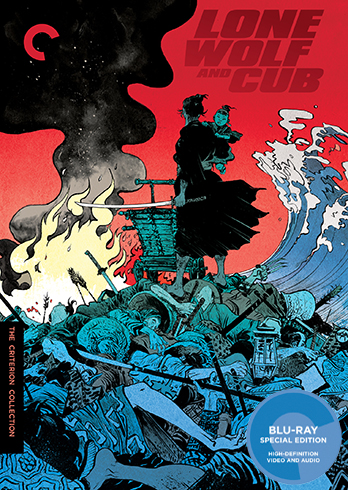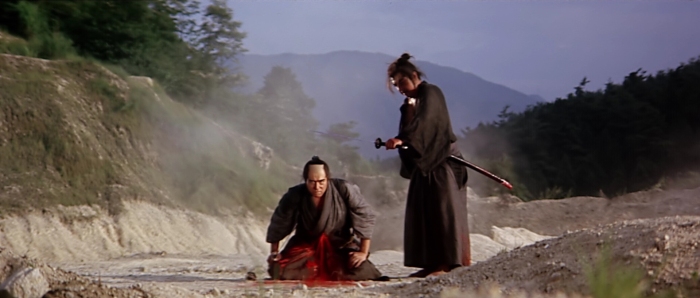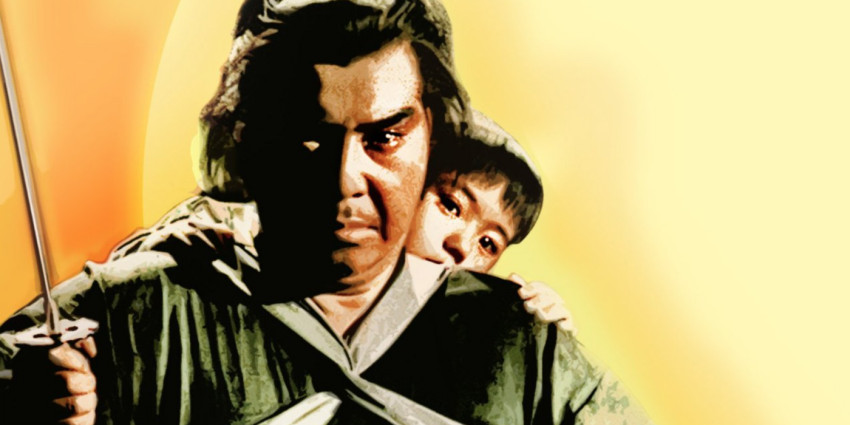Lone Wolf and Cub
March 31, 2017 · 0 comments
By Jeremy Clarke.
The Lone Wolf and Cub franchise began life as a manga in 1970 by writer Kazuo Koike and artist Goseki Kojima. It proved hugely popular in Japan, where in 1972 the first four of six films appeared. Two more followed in 1973 and 1974. Criterion’s new three-disc Blu-ray release collects together all six films with a clutch of extras.
 Lone Wolf and Cub: Sword of Vengeance is the debut that sets the characters up for the series. Itto Ogami (Tomisaburo Wakayama) is the chief executioner for the ruling Tokugawa Shogunate who acts as second to those condemned to commit hara-kiri, beheading them. Members of the Shadow Yagyu clan led by Retsudo Yagyu unjustly frame him as disloyal to the Shogun. They turn up at his house and slay his wife but Itto and his small son Daigoro (Akihiro Tomikawa) survive. Officially disgraced, Itto vows revenge. Daigoro must either take the same path or join his mother in death. Itto makes Daigoro choose between a sword, which represents the Demon Way in Hell, or a ball which represents ordinary childhood. After Daigoro chooses the sword, Itto styles himself the Lone Wolf and Cub assassin for hire at 500 ryo a kill. For the rest of the series he pushes Daigoro around Japan in a baby cart, meeting and despatching numerous adversaries.
Lone Wolf and Cub: Sword of Vengeance is the debut that sets the characters up for the series. Itto Ogami (Tomisaburo Wakayama) is the chief executioner for the ruling Tokugawa Shogunate who acts as second to those condemned to commit hara-kiri, beheading them. Members of the Shadow Yagyu clan led by Retsudo Yagyu unjustly frame him as disloyal to the Shogun. They turn up at his house and slay his wife but Itto and his small son Daigoro (Akihiro Tomikawa) survive. Officially disgraced, Itto vows revenge. Daigoro must either take the same path or join his mother in death. Itto makes Daigoro choose between a sword, which represents the Demon Way in Hell, or a ball which represents ordinary childhood. After Daigoro chooses the sword, Itto styles himself the Lone Wolf and Cub assassin for hire at 500 ryo a kill. For the rest of the series he pushes Daigoro around Japan in a baby cart, meeting and despatching numerous adversaries.
Sword of Vengeance pits Itto Ogami against both the Shadow Yagyu and a local gang of thugs. The second film Baby Cart at the River Styx ups the ante with ninja warriors, swordswomen and three fearsome fighters armed with a cudgel, spiked metal fists and a claw. As the body count mounts, the Yagyu kidnap Daigoro in an attempt to weaken Itto. The third film Baby Cart to Hades involves an encounter with a samurai who has been reduced to a mercenary status. Itto also rescues a woman sold into prostitution by taking physical punishment upon himself to pay off her debt. The same director, Kenji Misumi, made these three films, then took a break before returning for the fifth.
The fourth film, Baby Cart in Peril, is the only one to use voice-over narration to advance the plot. Director Buichi Saito seems in sync with the material, which includes a half-naked, tattooed swordswoman and Retsudo’s son Ganbei. Misumi leant a more familiar feel to the fifth film Baby Cart in the Land of Demons in which Daigoro unwittingly helps a lady pickpocket and a Lord tries to pass off his illegitimate five-year-old daughter as his legitimate son while locking the true heir away. Director Yoshiyuki Kuroda shifts tone to deliver both supernatural horror and spectacular snowbound action for the sixth film White Heaven in Hell. It doesn’t feel like the series’ final film as both Itto and Retsudo survive. The manga led up to Itto being killed by Retsudo who is in turn despatched by Daigoro. Wakamaya refused to make a seventh film as he was unhappy with how a concurrent TV series portrayed Itto.
Criterion’s Blu-ray puts three films plus their trailers on each of the first two discs. The third disc is all extras – biographer Kazuma Nozawa talks about Kenji Misumi, there’s a ten minute Kazuo Koike interview and a fascinating 52-minute, French-made documentary about the six films. This features interviews with the two single-film directors and many other crew members. A half-hour silent details how a Japanese sword is made while a 13-minute short covers the franchise’s swordsmanship techniques. Also included is Shogun Assassin (1980), the English dubbed re-edit of Sword of Vengeance and Baby Cart at the River Styx into one feature for US release.
 The particularly informative Koike interview is punctuated with images from the Lone Wolf and Cub manga, “my magnum opus, my number one” as he calls it. He and Kojima shared a mutual admiration for each other’s work and drank a lot together, which led to their collaboration on what would become 28 manga volumes. Koike made Itto Ogami vulnerable by having him accompanied by Daigoro, thus maintaining audience interest. He describes star Tomisaburo Wakayama’s bizarre, sword-wielding pitch to secure the part and the actor’s subsequent “really good” ideas for action sequences. He discusses his working relationship with director Kenji Misumi and the differences between the static medium of manga and the dynamic medium of film.
The particularly informative Koike interview is punctuated with images from the Lone Wolf and Cub manga, “my magnum opus, my number one” as he calls it. He and Kojima shared a mutual admiration for each other’s work and drank a lot together, which led to their collaboration on what would become 28 manga volumes. Koike made Itto Ogami vulnerable by having him accompanied by Daigoro, thus maintaining audience interest. He describes star Tomisaburo Wakayama’s bizarre, sword-wielding pitch to secure the part and the actor’s subsequent “really good” ideas for action sequences. He discusses his working relationship with director Kenji Misumi and the differences between the static medium of manga and the dynamic medium of film.
Shogun Assassin takes the first film’s set up and edits it into action sequences mostly from the second film. Working on the principle that US audiences wouldn’t want to hear characters speaking Japanese, much of the dialogue is excised with what’s left dubbed into American English. This is mostly accomplished by skilfully matching dubbed voices to shots where the mouth movements can’t be seen, with occasional lines in English written to fit Japanese mouth movements. Many of the plot’s finer points are simplified: Retsudo is turned into the Emperor while Itto Ogami is never actually named. Shogun Assassin adds a voice-over by Daigoro in which the child muses on his life wandering the land with his father. The music is augmented with an eighties keyboard-oriented score which has not aged well. The action from the second film survives largely intact. If the whole film is a lot more watchable than most dubbed live action movies, you still miss the characters’ verbal interaction. It sharply illustrates how US producers butchered the first two films for their domestic audiences in 1980. However the original six films have stood the test of time well.
Lone Wolf and Cub is released on Blu-ray by Criterion.

Leave a Reply